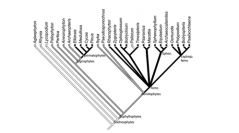

 Comptes Rendus Palevol
11 (6) - Pages 403-418
Comptes Rendus Palevol
11 (6) - Pages 403-418Recent paleobotanical studies suggest that megaphylls evolved several times in land plant evolution, implying that behind the single word “megaphyll” are hidden very different notions and concepts. We therefore review current knowledge about diverse foliar organs and related characters observed in fossil and living plants, using one phylogenetic hypothesis to infer their origins and evolution. Four foliar organs and one lateral axis are described in detail and differ by the different combination of four main characters: lateral organ symmetry, abdaxity, planation and webbing. Phylogenetic analyses show that the “true” megaphyll appeared at least twice in Euphyllophytes, and that the history of the four main characters is different in each case. The current definition of the megaphyll is questioned; we propose a clear and accurate terminology in order to remove ambiguities of the current vocabulary. Further analyses of megaphyll evolution need to consider new definitions and descriptors, as well as make use of improved phylogenetic hypotheses.
Euphyllophytes, Megaphyll, Bilateral symmetry, Abdaxity, Lamina, Phylogeny